Analysis of the Impact of the Coke Manufacturing Process on the Service Life of Siliceous Refractory
Abstract
1. Introduction
2. Materials and Methods
2.1. Aspects Inherent to the Process That may Deteriorate the Refractory
2.1.1. Hard Pushes (Mechanical Stress and Abrasion)
- Inadequate loading of coal mixture.If the charge is higher than necessary, not all the coal will be transformed into coke and consequently the needed shrinkage will not occur and greater resistance in the pushing of the oven will be generated [4].
- Incorrect charge density.Coal mixture must contain between 8 and 10 per cent of H2O. A deviation from this rate will affect the charge density and the thermal energy required to transform the coal into coke. Again, the shrinkage of the coke cake may be compromised and lead to a hard pushing [4].
- Low temperature.Incomplete transformation of the coal mixture due to poor heating is one of the most frequent causes of hard pushes. If there is a deficit of thermal energy supplied by the combustion chambers to the coking chambers, the transformation of the mixture of coals into coke will not be carried out completely and, therefore, the reduction and separation of the oven walls will not take place.
- Hight temperature.Excessive energy input into the coke mixture will accelerate the process of transformation into coke, provoking a reduction of coke size in the final stage and making it mechanically less consistent and more difficult to extract.Damage to the refractory.Deformation or damage to the refractory, which prevents the coke from sliding through the oven, can lead to “hard” pushes, which can also generate damage in other areas of the ovens.
- Carbon deposits on the oven walls.The gas obtained during coking can crack, producing carbon deposits (graphite) on the walls. This graphite turns into an obstacle during the pushing of the oven [4].
- Deviation in the coking time.For a given battery production schedule, there must be a selection of time for the coal to remain in the oven. This time is set precisely, according to the calories provided during combustion, which in turn depends on the average temperature target of the battery. The coking time must be the same for all the ovens. That is, for a given amount of coal, a given oven geometry and a fixed calorific input, the residence time should be equal. This concept is called global coking time (GCT).Positive deviation occurs when the charge remains in the oven for a period of time longer than scheduled. In this case the coke undergoes the “high temperature” effect, as stated before. Negative deviation occurs when the charge remains in the oven for a period of time shorter than scheduled, provoking the “low temperature” effect in the coke [4].
- Inadequate coal mix.The mixture must be composed of coals with coking characteristics. This means that, with adequate heating, the cake can contract and separate from the oven walls, facilitating its extraction [21]. If an error has previously occurred in the mixing of the coals, their behavior in the oven will be affected by exerting a high resistance when extracted.
2.1.2. Sticky Ovens (Mechanical Stress, Abrasion and Cooling of Refractory)
2.2. Characteristics of Silica Refractories
2.2.1. Thermal Conductivity
2.2.2. Refractoriness under Load
2.2.3. Cold Compressive Strength
- The weight of its own masonry;
- The charging cars;
- The weight of the coal;
- The armatures and metal closures;
- The efforts exerted in the pushes, especially in the “hard pushes”.
2.2.4. Expansion
2.2.5. Thermal Shock Rupture
2.2.6. Resistance to Chemical Attack
- The refractory must be resistant to the action of the components of the coal mixture and to the effect of carbon deposits on the oven walls;
- It has excellent resistance to acid slag;
- Up to 1550 °C, it has an acceptable resistance to basic slags;
- It resists well the attacks by iron, ferruginous slags and sodium-calcium glasses [24];
2.3. Methodology
2.3.1. Data Collection
- Hard pushes;
- Sticky ovens;
- The scope of repairs to the refractory.
2.3.2. Data Processing
- Hard pushes
- Sticky ovens
- Ovens with refractory repairs
3. Results
3.1. Hard Pushes
3.2. Sticky Ovens
3.3. Ovens with Damage (Repaired)
3.4. Interpretation of Results
3.4.1. Hard Pushes Versus Repairs
3.4.2. Sticky Ovens versus Repairs
4. Discussion
5. Conclusions
Author Contributions
Funding
Institutional Review Board Statement
Informed Consent Statement
Data Availability Statement
Conflicts of Interest
References
- Nashan, G.; Rohde, W.; Wessiepe, K. Some figures and facts on the present status and new proposals for a future oriented cokemaking technology. Cokemak. Int. 2002, 12, 50–55. [Google Scholar]
- Gudenau, H.W.; Senk, D.; Fukada, K.; Babich, A.; Froehling, C.; García, L.L.; Formoso, A.; Alguacil, F.J.; Cores, A. Coke, char and organic waste behaviour in the blast furnace with high injection rate. Rev. Metal. 2003, 39, 367–377. [Google Scholar] [CrossRef]
- Álvarez, R.; García-Cimadevilla, J.L.; Díez, M.A.; Barriocanal, C. La tecnología de producción de coque de horno alto ante el nuevo milenio. Rev. Metal. Madrid Vol. Extr. 2005, 41, 29–34. [Google Scholar] [CrossRef]
- Lorenzo, E.; García, J. Manual de Hornos de Cok y Subproductos; Empresa Nacional siderúrgica, S.A.: Avilés, España, 1989. [Google Scholar]
- Pérez, E. Materiales refractarios para hornos de coque. Boletín Inf. Inst. Nac. Carbón (INCAR) 1955, 4, 231–250. [Google Scholar]
- UNE-EN 12475-1:1998; Clasificación de los Productos Refractarios Conformados Densos. Parte 1: Productos Sílico-Aluminosos. Comité Europeo para la Estandarización: Brussels, Belgium, 1998.
- Brunk, F. Silica bricks for modern coke oven batteries. Cokemak. Int. 2000, 14, 37–40. [Google Scholar]
- Córdova, M.; Madias, J. Coke Oven Life Prolongation. A Multi-Disciplinary Approach. In Proceedings of the 45th Ironmaking, 16th Iron Ore, Part of the ABM Week, Rio de Janeiro, Brazil, 17–21 August 2015. [Google Scholar]
- Lee, W.; Lee, Y. Internal gas pressure characteristics generated during coal carbonization in a coke oven. Energy Fuel 2001, 15, 618–623. [Google Scholar] [CrossRef]
- Crelling, J.C.; Suárez-Ruiz, I. The role of petrology in coal utilization. In Applied Coal Petrology; Elsevier: Amsterdam, The Netherlands, 2008; pp. 173–192. [Google Scholar]
- Harris, W. The reaction of coal ash with coke oven bricks. Ironmak. Proc. Metall. Soc. 1987, 45, 475–478. [Google Scholar]
- Ishikawa, Y. Operational Strategy for Coke Ovens in Japan; World Steel Association: London, UK, 1985; pp. 88–96. [Google Scholar]
- Arcuri, S.; Cordova, M.; Traglia, M. Improvements at SIDERAR´s coke oven batteries to extend their useful life. In Proceedings of the 60th Ironmaking Conference, Baltimore, MD, USA, 25–28 March 2001. [Google Scholar]
- Kelling, A. Continuous development for a longer battery life at the Rautaruukki Steel Coking Plant in Raahe. In Proceedings of the AISE Annual Convention and Exposition, Finland; 2001; pp. 1–22. [Google Scholar]
- Komaki, I.; Matsuo, T.; Kogushi, Y.; Nishimoto, K.; Yamamoto, H. Coke oven diagnosis and repair techniques. In Proceedings of the 60th Ironmaking Conference, Baltimore, MD, USA, 25–28 March 2001; pp. 595–605. [Google Scholar]
- Álvarez, J.M. Manual de Carbones; Empresa Nacional Siderúrgica S.A.: Avilés, España, 1990. [Google Scholar]
- Badiuzzamah, M. Design Optimization of Coke Pusher Ram; Mcmaster University: Hamilton, ON, Canada, 1969. [Google Scholar]
- Shimoyama, I.; Yamamoto, T.; Fukada, K. Tolerable Limit of Localized Force on Damaged Coke Oven Wall Analyzed by Discrete Element Method. ISIJ Int. 2010, 50, 1048–1053. [Google Scholar] [CrossRef][Green Version]
- Gayle, J.B.; Eddy, W.H. Carbonizing Test with Tuscaloosa oven Studies of Pushing Pressures; US Dept. of the Interior, Bureau of Mines: Washington, DC, USA, 1961. [Google Scholar]
- Ruecki, R. Refractories Handbook; Schacht, C.A., Ed.; Marcel Decker Inc.: New York, NY, USA, 2004. [Google Scholar]
- Shinohara, Y. Refractories Handbook; Japanese Association of Refractories: Tokyo, Japan, 1998. [Google Scholar]
- Jordan, P. Development of Small Scale Techniques Used to Study Coking Pressure Generation; Loughborough University of Technology: Loughborough, UK, 1992; p. 26. [Google Scholar]
- Norma DIN 1089-1 (1995); Refractarios para uso en Hornos de Coke. Parte 1: Ladrillos Silíceos, Requisitos y Ensayos. DIN Instituto Alemán Para la Normalización: Berlin, Germany, 1995.
- De Aza, S. Jornadas Técnicas sobre el Diseño, Propiedades y Aplicaciones de los Materiales Refractarios; UAM: Madrid, Spain, 2004. [Google Scholar]
- Nomura, S.; Terashima, H.; Sato, E.; Naito, M. Some Fundamental Aspects of Highly Reactive Iron Coke Production. ISIJ Int. 2007, 47, 823–830. [Google Scholar] [CrossRef]

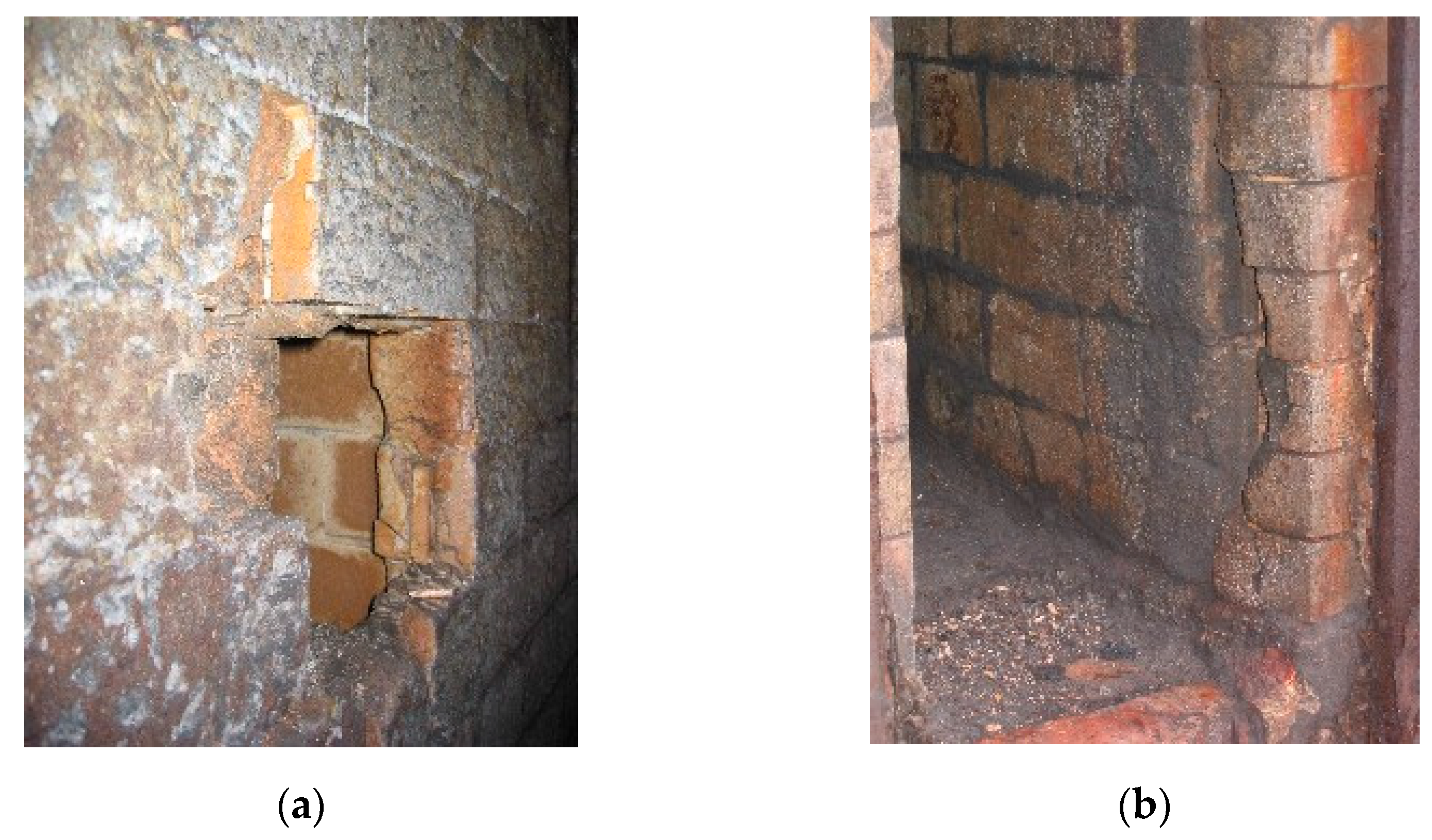
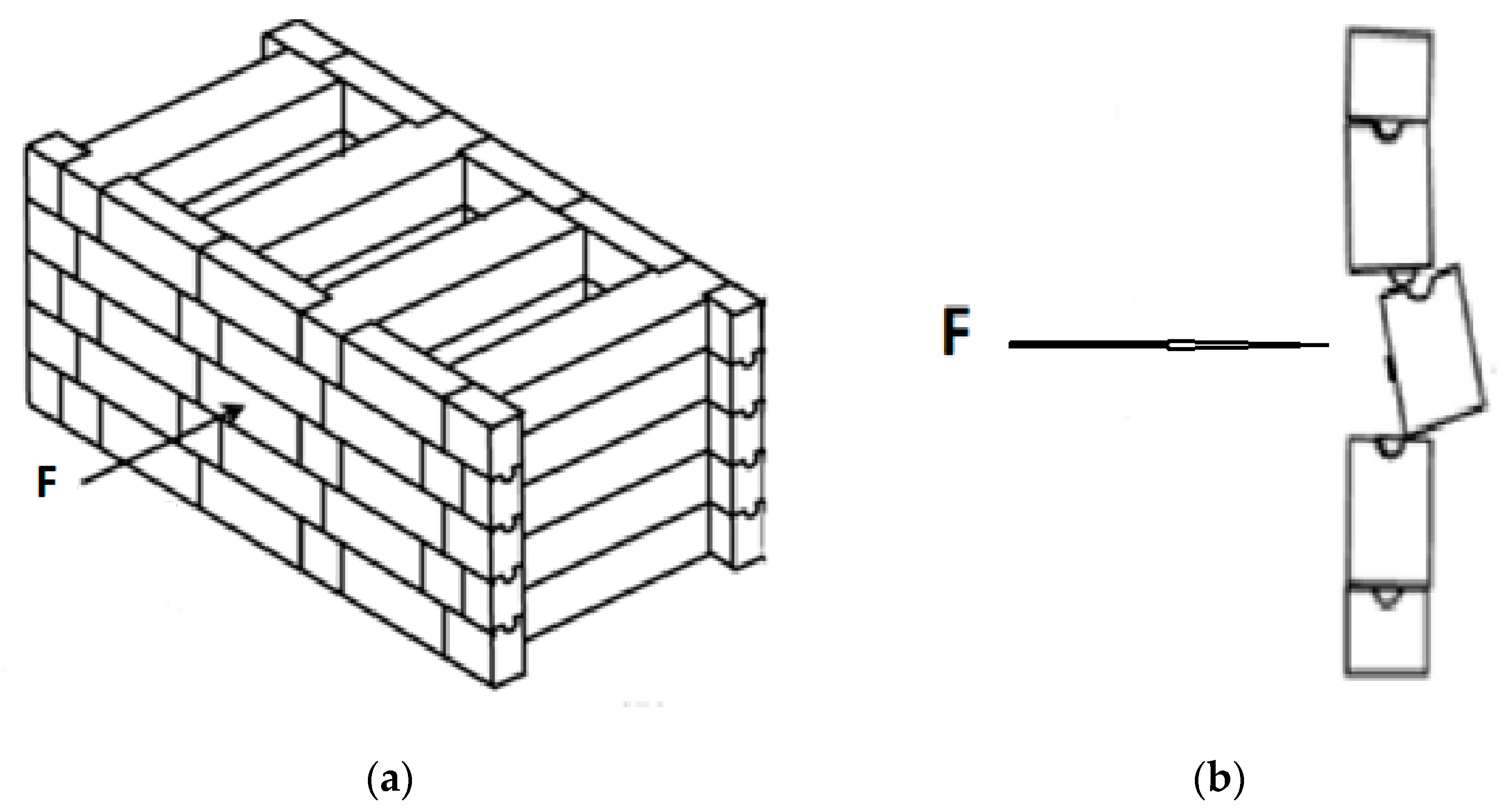
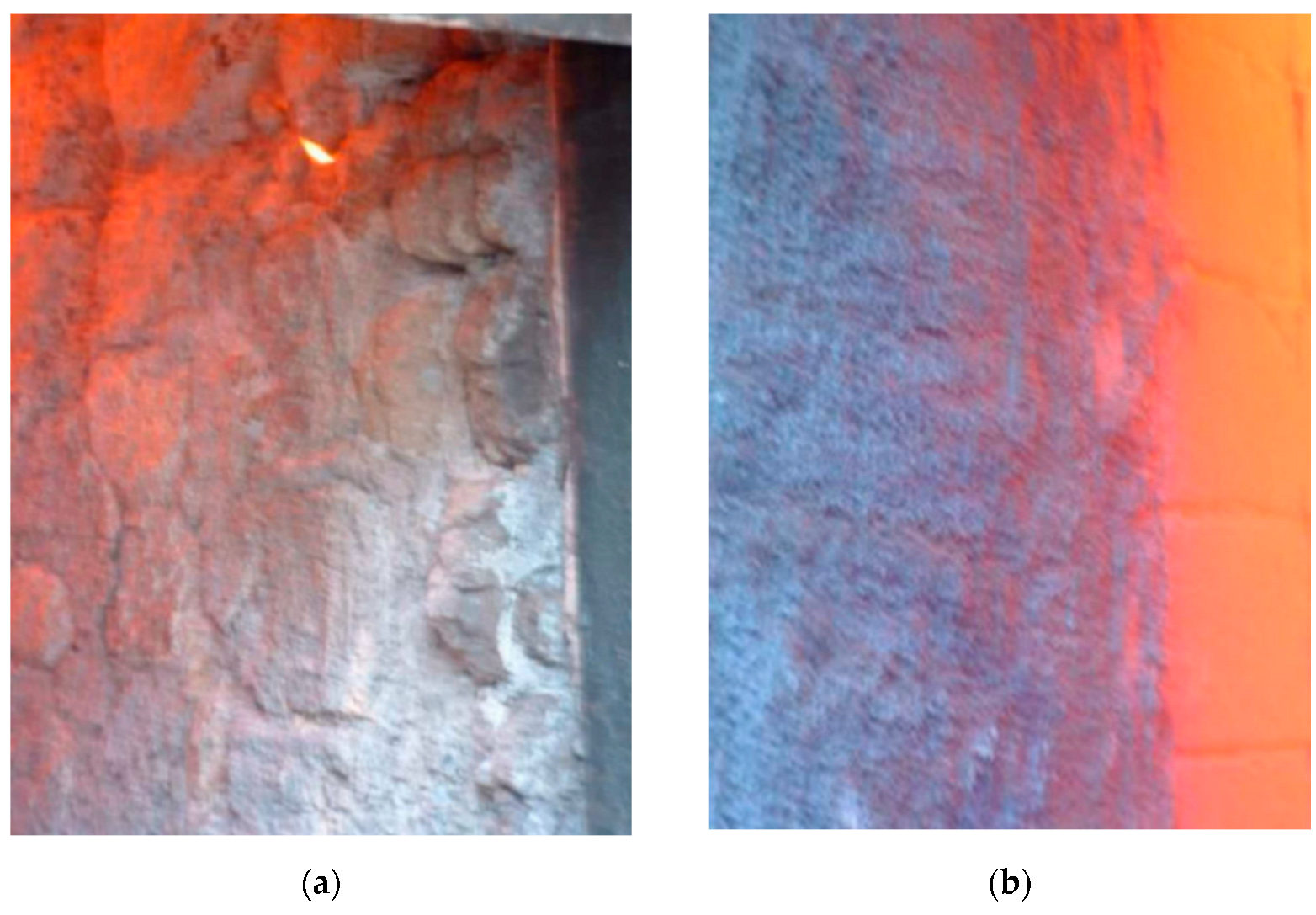
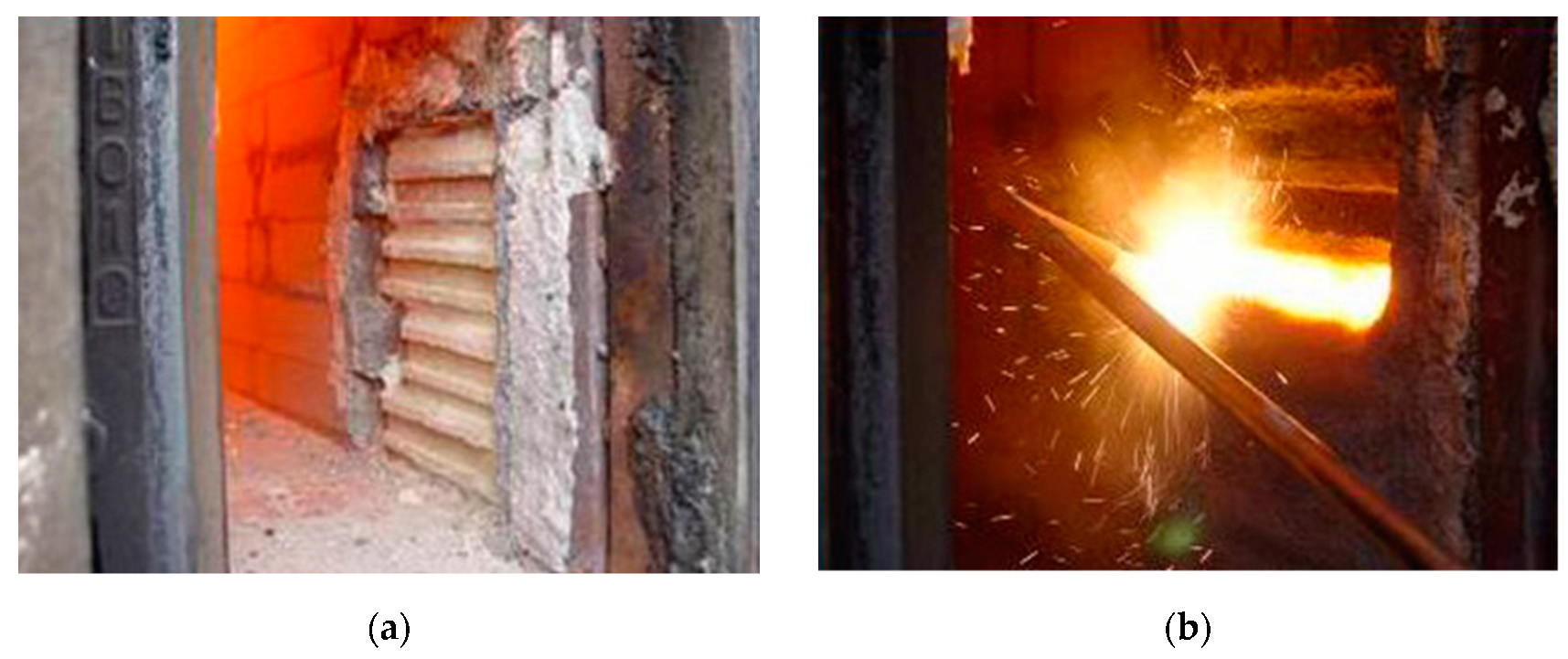
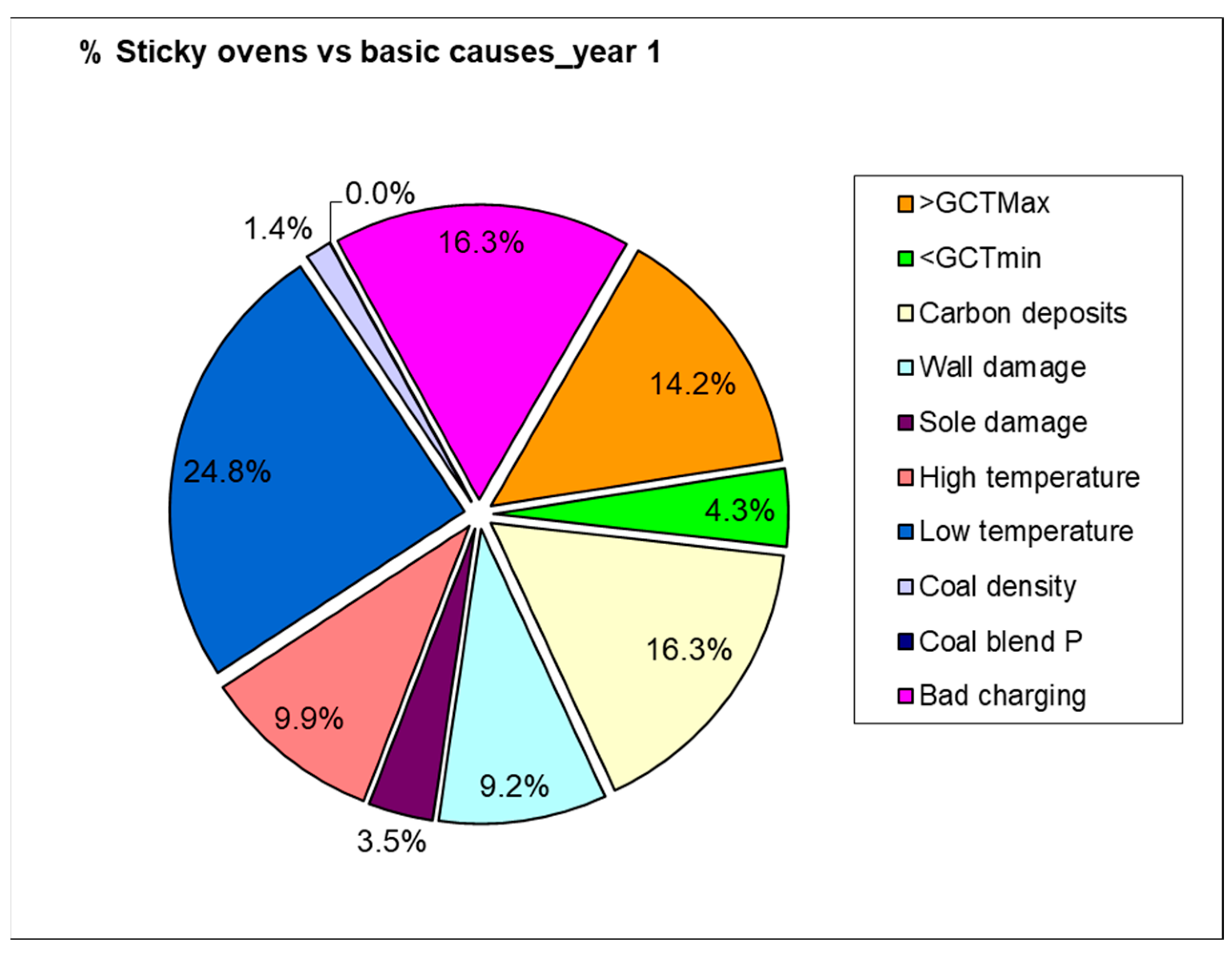
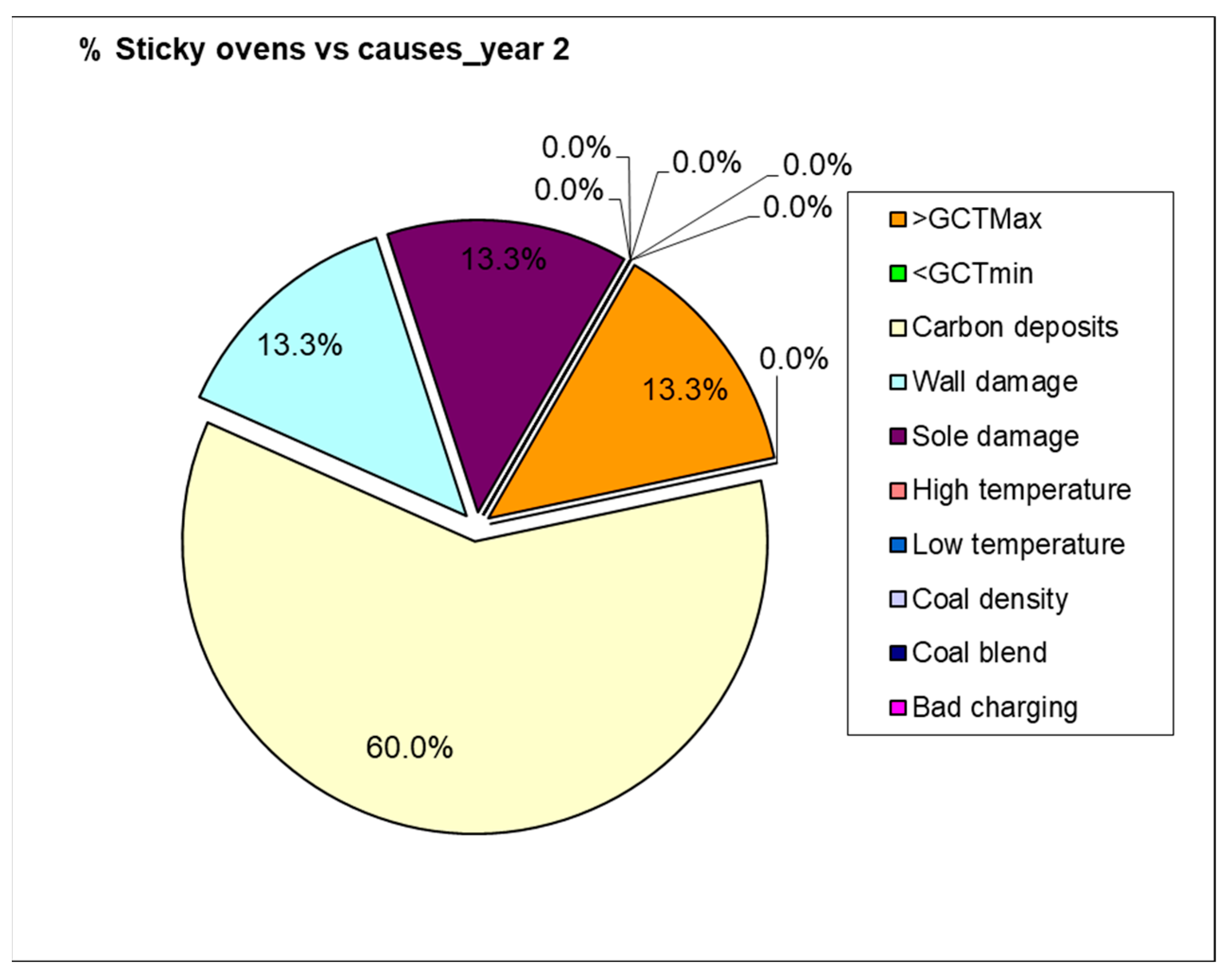


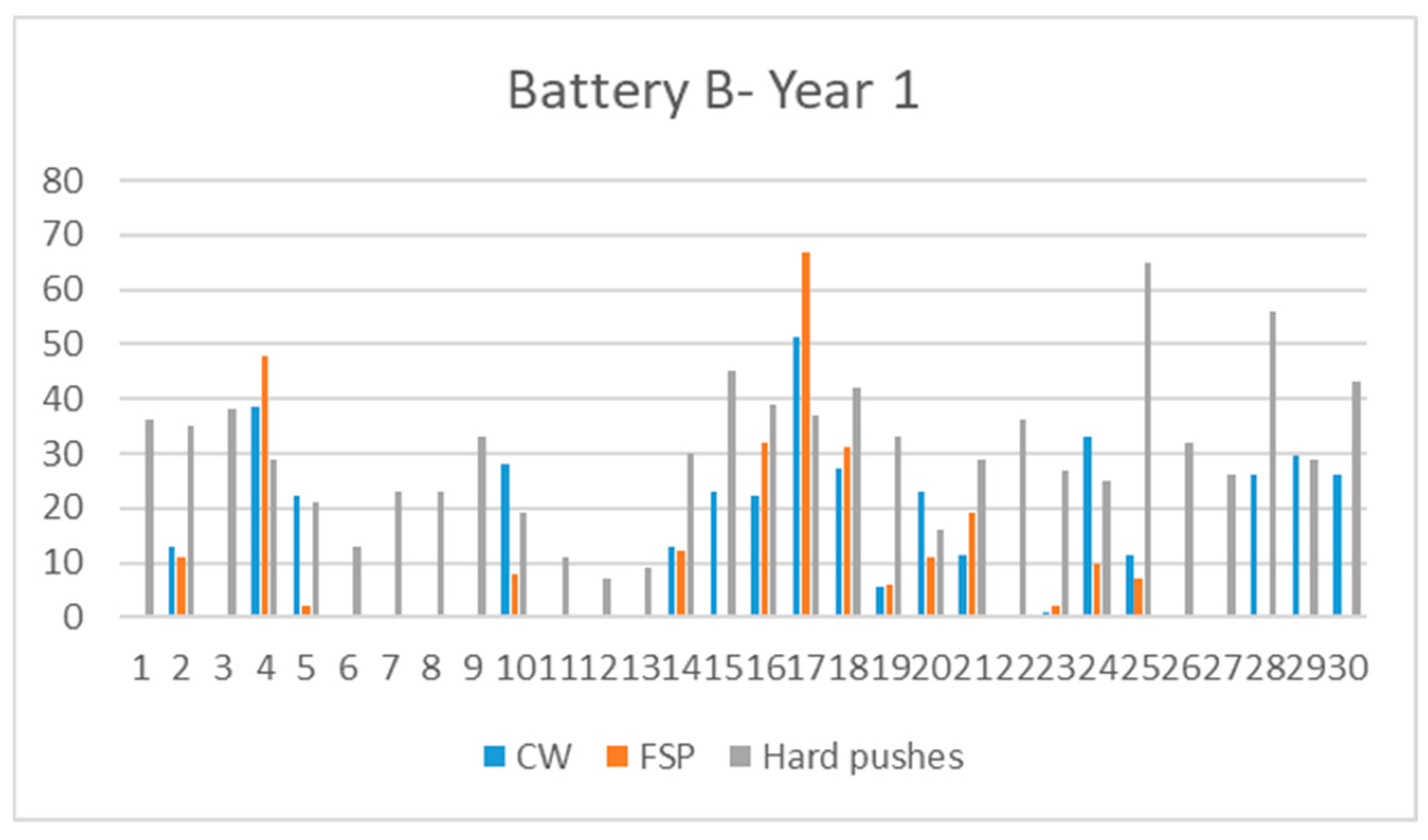
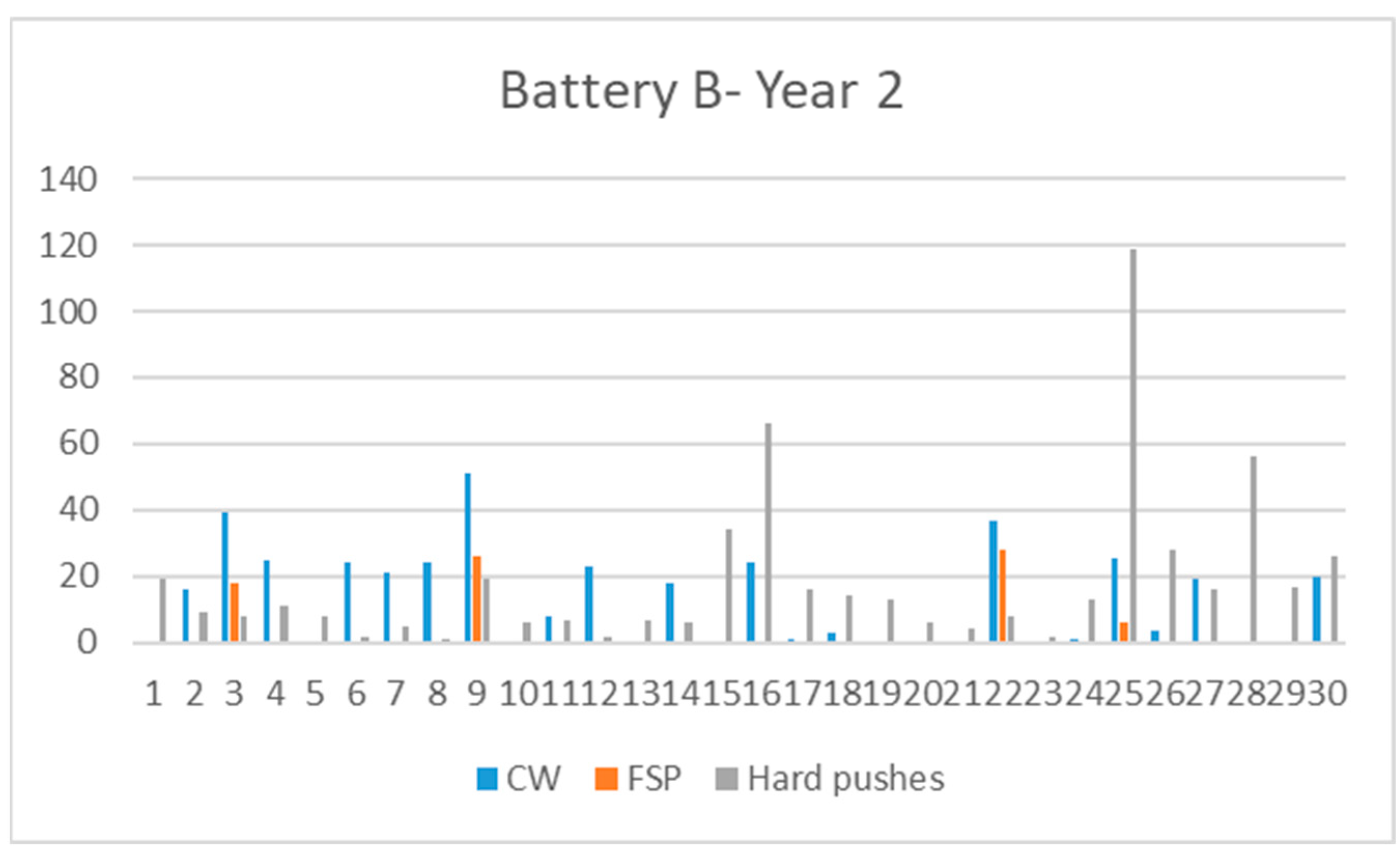

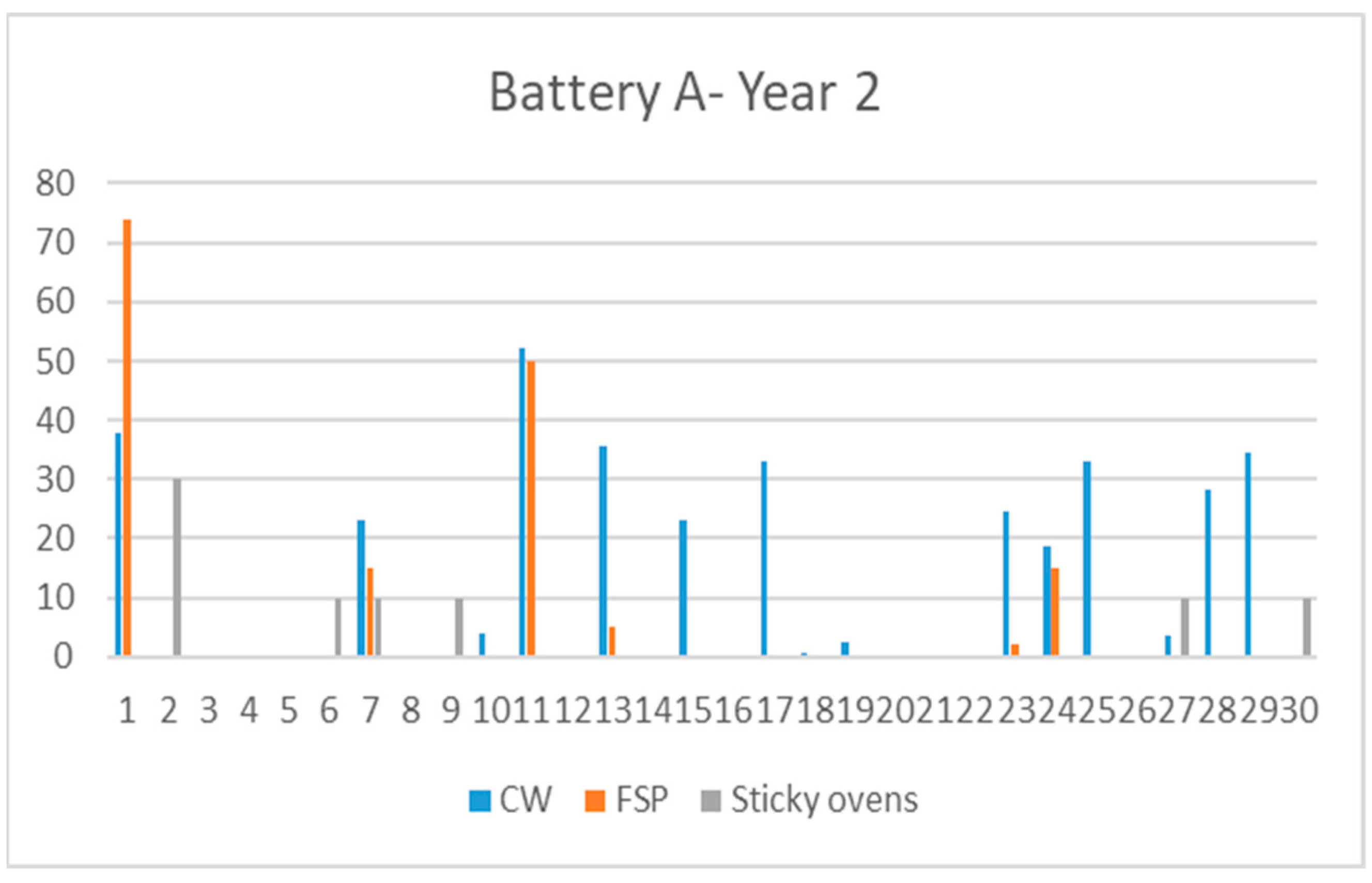
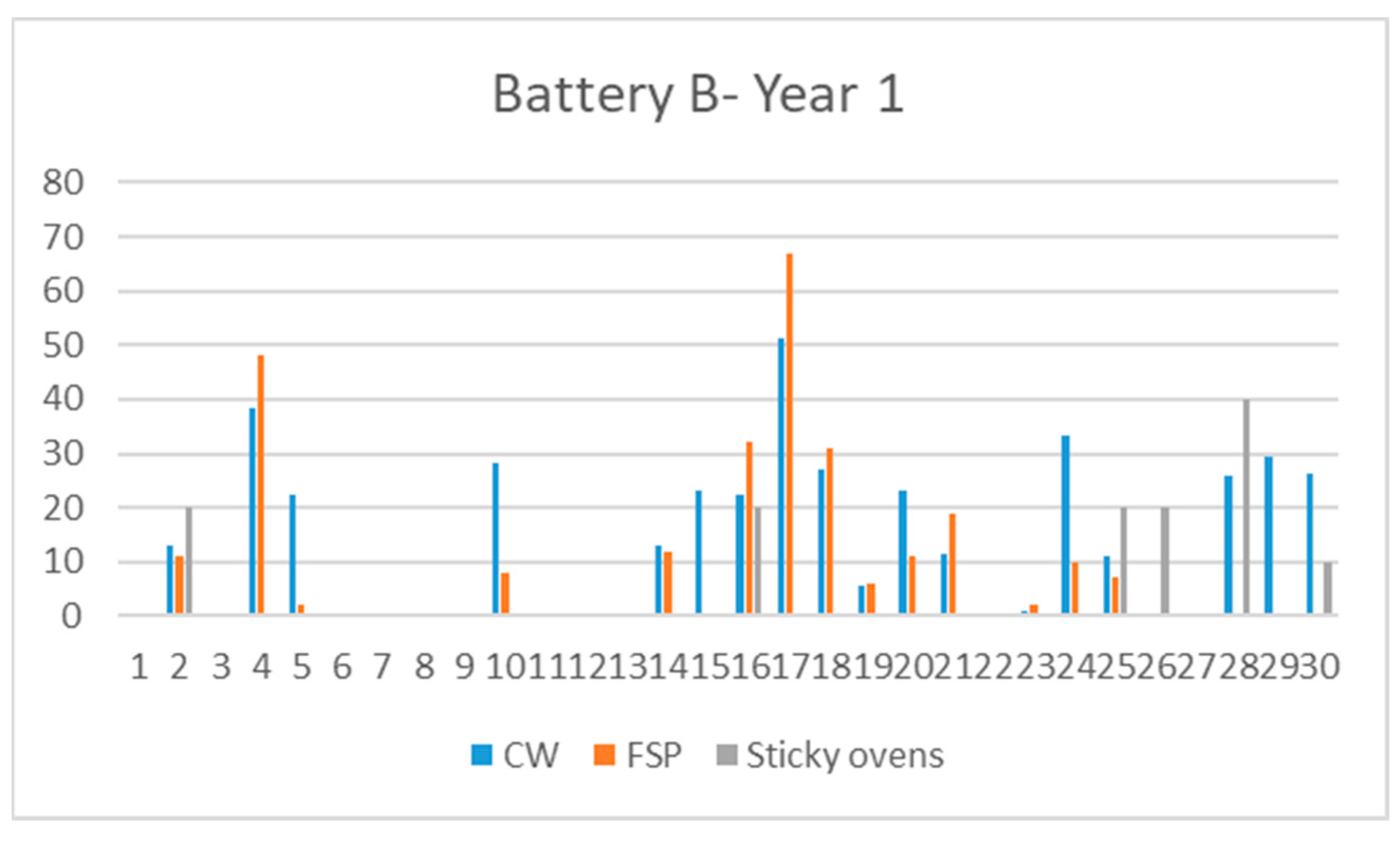
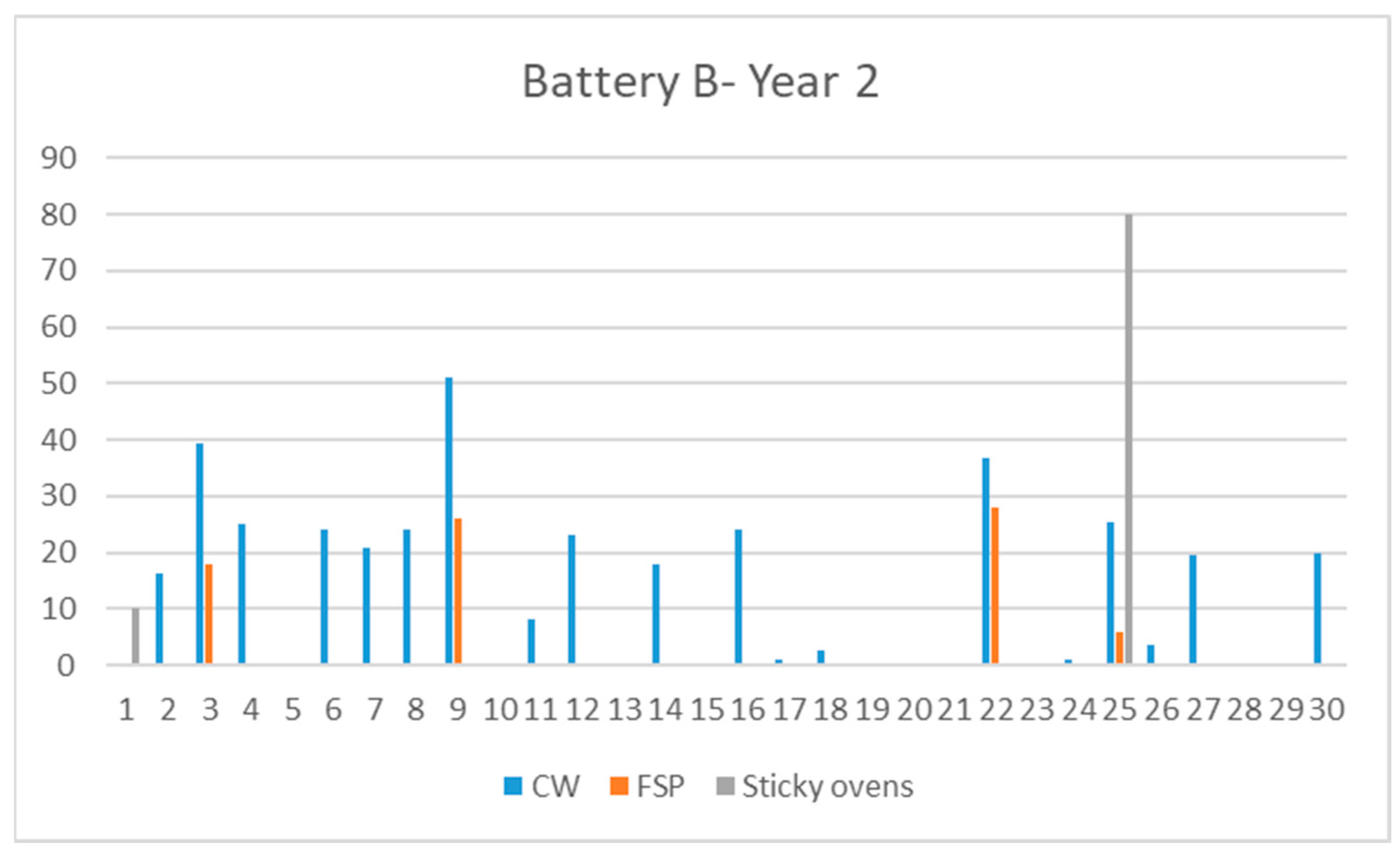
| Parameter | Unit | Value |
|---|---|---|
| SiO2 | % | ≥94.5 |
| Al2O3 | % | ≤2.0 |
| Fe2O3 | % | ≤1.0 |
| CaO | % | ≤3.0 |
| Na2O + K2O | % | ≤0.35 |
| Apparent porosity | % | ≤24.5 |
| Cold compressive strength | N/mm2 | ≥28 |
| Refractoriness under load | °C | ≥1640 |
| Density | g/cm3 | 1.82 |
| Linear thermal expansion | % | 1.26 |
| Residual quartz | % | 1.5 ± 0.5 |
| Year 1 | Year 2 | Year 1 | Year 2 | ||||||
|---|---|---|---|---|---|---|---|---|---|
| Oven | N° | % | N° | % | Oven | N° | % | N° | % |
| A1 | 36 | 7 | 13 | 2.5 | B1 | 36 | 7 | 19 | 3.72 |
| A2 | 51 | 10 | 43 | 8.4 | B2 | 35 | 6.8 | 9 | 1.76 |
| A3 | 37 | 7.2 | 26 | 5.1 | B3 | 38 | 7.4 | 8 | 1.57 |
| A4 | 54 | 11 | 24 | 4.7 | B4 | 29 | 5.7 | 11 | 2.15 |
| A5 | 44 | 8.6 | 31 | 6.1 | B5 | 21 | 4.1 | 8 | 1.57 |
| A6 | 33 | 6.5 | 31 | 6.1 | B6 | 13 | 2.5 | 2 | 0.39 |
| A7 | 32 | 6.3 | 30 | 5.9 | B7 | 23 | 4.5 | 5 | 0.98 |
| A8 | 30 | 5.9 | 45 | 8.8 | B8 | 23 | 4.5 | 1 | 0.20 |
| A9 | 30 | 5.9 | 22 | 4.3 | B9 | 33 | 6.5 | 19 | 3.72 |
| A10 | 38 | 7.4 | 39 | 7.6 | B10 | 19 | 3.7 | 6 | 1.17 |
| A11 | 44 | 8.6 | 28 | 5.5 | B11 | 11 | 2.2 | 7 | 1.37 |
| A12 | 31 | 6.1 | 9 | 1.8 | B12 | 7 | 1.4 | 2 | 0.39 |
| A13 | 29 | 5.7 | 8 | 1.6 | B13 | 9 | 1.8 | 7 | 1.37 |
| A14 | 41 | 8 | 20 | 3.9 | B14 | 30 | 5.9 | 6 | 1.17 |
| A15 | 36 | 7 | 21 | 4.1 | B15 | 45 | 8.8 | 34 | 6.65 |
| A16 | 51 | 10 | 33 | 6.5 | B16 | 39 | 7.6 | 66 | 12.92 |
| A17 | 43 | 8.4 | 18 | 3.5 | B17 | 37 | 7.2 | 16 | 3.13 |
| A18 | 30 | 5.9 | 4 | 0.8 | B18 | 42 | 8.2 | 14 | 2.74 |
| A19 | 26 | 5.1 | 12 | 2.3 | B19 | 33 | 6.5 | 13 | 2.54 |
| A20 | 18 | 3.5 | 9 | 1.8 | B20 | 16 | 3.1 | 6 | 1.17 |
| A21 | 42 | 8.2 | 17 | 3.3 | B21 | 29 | 5.7 | 4 | 0.78 |
| A22 | 26 | 5.1 | 8 | 1.6 | B22 | 36 | 7 | 8 | 1.57 |
| A23 | 39 | 7.6 | 9 | 1.8 | B23 | 25 | 5.3 | 2 | 0.39 |
| A24 | 36 | 7 | 10 | 2 | B24 | 25 | 4.9 | 13 | 2.54 |
| A25 | 47 | 9.2 | 35 | 6.8 | B25 | 65 | 13 | 119 | 23.29 |
| A26 | 45 | 8.8 | 20 | 3.9 | B26 | 32 | 6.3 | 28 | 5.48 |
| A27 | 57 | 11 | 14 | 2.7 | B27 | 26 | 5.1 | 16 | 3.13 |
| A28 | 48 | 9.4 | 21 | 4.1 | B28 | 56 | 11 | 56 | 10.96 |
| A29 | 31 | 6.1 | 21 | 4.1 | B29 | 29 | 5.7 | 17 | 3.33 |
| A30 | 32 | 6.3 | 12 | 2.3 | B30 | 43 | 8.4 | 26 | 5.09 |
| Year 1 | Year 2 | Year 1 | Year 2 | ||
|---|---|---|---|---|---|
| Oven | N° | N° | Oven | N° | N° |
| A1 | 1 | B1 | 1 | ||
| A2 | 7 | 3 | B2 | 2 | |
| A3 | B3 | ||||
| A4 | 3 | B4 | |||
| A5 | 1 | B5 | |||
| A6 | 1 | B6 | |||
| A7 | 1 | 1 | B7 | ||
| A8 | 2 | B8 | |||
| A9 | 1 | B9 | |||
| A10 | B10 | ||||
| A11 | 9 | B11 | |||
| A12 | 4 | B12 | |||
| A13 | 4 | B13 | |||
| A14 | 14 | B14 | |||
| A15 | B15 | ||||
| A16 | 1 | B16 | 2 | ||
| A17 | B17 | ||||
| A18 | B18 | ||||
| A19 | 1 | B19 | |||
| A20 | B20 | ||||
| A21 | 3 | B21 | |||
| A22 | 2 | B22 | |||
| A23 | 1 | B23 | |||
| A24 | 1 | B24 | |||
| A25 | 2 | B25 | 2 | 8 | |
| A26 | 1 | B26 | 2 | ||
| A27 | 1 | 1 | B27 | ||
| A28 | 4 | B28 | 4 | ||
| A29 | 1 | B29 | |||
| A30 | 1 | B30 | 1 |
| Year 1 | Year 2 | Year 1 | Year 2 | ||||||
|---|---|---|---|---|---|---|---|---|---|
| Oven | CW | FSP | CW | FSP | Oven | SC | FSP | CW | FSP |
| A1 | 2625 | 3850 | 74 | B1 | 0 | 0 | |||
| A2 | B2 | 1300 | 11 | 1625 | |||||
| A3 | 1875 | B3 | 0 | 3925 | 18 | ||||
| A4 | 2725 | 5 | B4 | 3850 | 48 | 2500 | |||
| A5 | 3825 | 26 | B5 | 2225 | 2 | 0 | |||
| A6 | 3275 | 4 | B6 | 0 | 2400 | ||||
| A7 | 1025 | 2375 | 15 | B7 | 0 | 2100 | |||
| A8 | 900 | 4 | B8 | 0 | 2400 | ||||
| A9 | 2050 | 3 | B9 | 0 | 5125 | 26 | |||
| A10 | 2425 | 400 | B10 | 2825 | 8 | 0 | |||
| A11 | 2575 | 5325 | 55 | B11 | 0 | 825 | |||
| A12 | 3950 | 7 | B12 | 0 | 2300 | ||||
| A13 | 1150 | 3550 | 5 | B13 | 0 | 0 | |||
| A14 | 2225 | B14 | 1300 | 12 | 1800 | ||||
| A15 | 1700 | 6 | 2325 | B15 | 2300 | 0 | |||
| A16 | 3300 | 72 | B16 | 2225 | 32 | 2425 | |||
| A17 | 5450 | 70 | 3325 | B17 | 5125 | 67 | 100 | ||
| A18 | 750 | 4 | 75 | B18 | 2725 | 31 | 275 | ||
| A19 | 75 | 25 | B19 | 550 | 6 | 0 | |||
| A20 | 1900 | 6 | B20 | 2325 | 11 | 0 | |||
| A21 | 1650 | B21 | 1150 | 19 | 0 | ||||
| A22 | 3400 | 10 | B22 | 0 | 3675 | 28 | |||
| A23 | 125 | 2 | 2450 | 2 | B23 | 75 | 2 | 0 | |
| A24 | 1875 | 15 | B24 | 3325 | 10 | 100 | |||
| A25 | 3325 | B25 | 1125 | 7 | 2550 | 6 | |||
| A26 | 650 | B26 | 0 | 350 | |||||
| A27 | 0 | 375 | B27 | 0 | 1950 | ||||
| A28 | 1475 | 15 | 2825 | B28 | 2600 | 0 | |||
| A29 | 3450 | B29 | 2950 | 0 | |||||
| A30 | B30 | 2625 | 2000 | ||||||
Publisher’s Note: MDPI stays neutral with regard to jurisdictional claims in published maps and institutional affiliations. |
© 2022 by the authors. Licensee MDPI, Basel, Switzerland. This article is an open access article distributed under the terms and conditions of the Creative Commons Attribution (CC BY) license (https://creativecommons.org/licenses/by/4.0/).
Share and Cite
Álvarez López, D.; García García, M. Analysis of the Impact of the Coke Manufacturing Process on the Service Life of Siliceous Refractory. Appl. Sci. 2022, 12, 13015. https://doi.org/10.3390/app122413015
Álvarez López D, García García M. Analysis of the Impact of the Coke Manufacturing Process on the Service Life of Siliceous Refractory. Applied Sciences. 2022; 12(24):13015. https://doi.org/10.3390/app122413015
Chicago/Turabian StyleÁlvarez López, David, and Manuel García García. 2022. "Analysis of the Impact of the Coke Manufacturing Process on the Service Life of Siliceous Refractory" Applied Sciences 12, no. 24: 13015. https://doi.org/10.3390/app122413015
APA StyleÁlvarez López, D., & García García, M. (2022). Analysis of the Impact of the Coke Manufacturing Process on the Service Life of Siliceous Refractory. Applied Sciences, 12(24), 13015. https://doi.org/10.3390/app122413015






